Types of Vines on Fences (With Pictures) – Identification Guide

Vines are a great addition to your backyard for color, privacy, and shelter. Climbing plants grow quickly and cover chain link fences, walls, eyesores, trellises, pergolas, and other structures in the garden. The beauty of growing fence-friendly vines is that they attach themselves easily and grow without much effort or maintenance.
Many types of vines can be grown on fences, each with its own unique characteristics. For example, flowering vines add a splash of color and fragrant blooms to backyards and help attract pollinators to spring and summer gardens. On the other hand, evergreen vining plants on fences provide year-long privacy and shelter from the elements.
When choosing the type of vining plants to grow on fences and walls, there are several considerations. For example, do you want to grow a deciduous or evergreen vine? Do you want a flowering vine that blooms throughout the summer? And is the vine suitable for your USDA growing zone and sun exposure?
This article provides an overview of some of the best types of flowering and evergreen plants to cover a fence with vines. The best climbing and trailing plants will add color and beauty to your outdoor space. Additionally, descriptions and pictures of vines will help you make an informed choice for growing over your backyard fence.
What Are Vines to Cover Fences?
Vines to cover fences are climbing plants that grow quickly and attach themselves to fence posts, chain link fences, and other structures. Vining plants like honeysuckle, trumpet vines, clematis, and wisteria provide a pop of vibrant colors to a backyard. If you need evergreen vines on fences, English ivy, creeping fig, and coral plant are some of the best choices.
Flowering Vines to Cover Fences
Flowering vines to cover fences are a great way to add a variety of color and beauty to your outdoor space. Let’s look in detail at some of the most popular flowering vines for fences. You will also get some helpful tips on where to plant the flowering vines for the best results.
Honeysuckle (Lonicera)

You can use the hardy flowering honeysuckle as a climber to cover unsightly fences or walls
Honeysuckle is a type of fast-growing flowering vine that scrambles over fences, walls, and trellises. Honeysuckle vines are known for their sweet-smelling flowers, dark green foliage, and vining habit. The vining plants produce clusters of fragrant flowers in rich red and pastel colors. In the fall, small orange berries adorn the plant.
Honeysuckle perennial vines are suitable for growing in full sun in USDA zones 4 through 9. In the warmer southern states, honeysuckle vines are evergreen and retain their foliage through mild winters. Most honeysuckle vines bloom from late spring through late fall. Depending on the variety, they can grow 20 to 25 ft. (6 – 7.6 m) high.
Although Japanese honeysuckle is a fast-growing vine for fences, it is an invasive species and can take over a backyard.
Trumpet Vine (Campsis radicans)
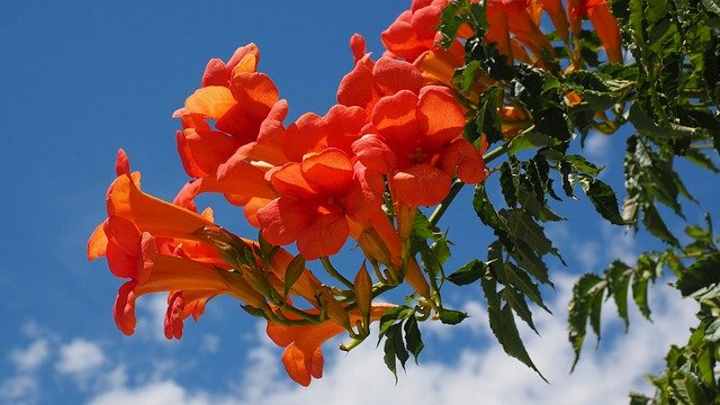
Trumpet vine is a fast growing creeper that can grow on fences and has orange-reddish flowers
The trumpet vine is a red-flowering deciduous vine with flower clusters of eye-catching red or orange funnel-shaped blossoms. The tubular flowers bloom throughout summer, attracting hummingbirds and pollinators. Additionally, the densely growing dark green leaves provide privacy as the flowering vine covers fences and walls.
Trumpet vine flowers grow 3” (7.5 cm) long and have curled petals forming a tubular trumpet shape. The attractive orange-red flowers grow in clusters at the ends of trailing or climbing stems. After flowering, brown seed pods appear on the vine.
This beautiful vine attaches itself to wooden fences, chain link fencing, trellises, or stone walls by aerial rootlets. The free-flowering vine grows 20 to 40 ft. (6 – 12 m) tall. It can also spread across the ground, making the plant ideal for fast-growing ground cover in full sun for USDA zones 5 to 9.
Nasturtium (Tropaoelum majus)

Nasturtium vine can quickly climb on trellises and fences, covering them with decorative orange flowers
Nasturtium is an easy-to-grow vining or climbing annual or short-lived perennial with masses of funnel-shaped orange attractive flowers. Ornamental features of this beautiful trellis plant are its disc-shaped green leaves, attractive red, orange, yellow, or white flowers, and sweet scent. Nasturtium flowers bloom during summer in colder climates and from late winter in warmer regions.
Climbing nasturtium plants grow between 6 and 10 ft. (1.8 – 3 m) tall and can quickly cover fences, posts, tree trunks, pergolas, or trellises. The flowering vines are suitable for growing in USDA zones 2 to 11. In warm climates, the vines are self-seeding and can become an invasive plant species.
Silver Lace Vine (Polygonum aubertii)
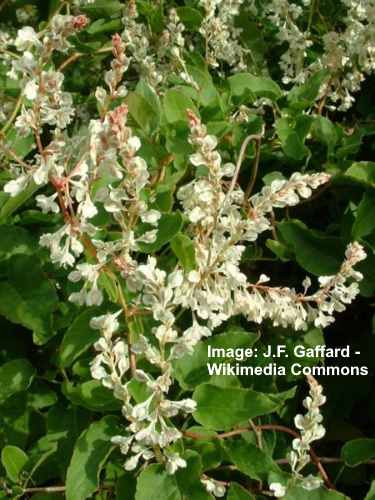
Silver lace vine is a fast growing white flowering vine for covering walls, fences or lattices
Silver lace vine is a deciduous white-flowering twining plant with clusters of dainty white flowers. The spreading woody vine is exceedingly fast-growing and is perfect for covering chain link fences, chicken wire, or similar unsightly barriers. The sprays of white flowers add color during summer and fall, and the green leaves provide privacy.
Silver lace vine is suitable for growing in full sun or partial shade in USDA zones 4 through 8. The climbing plant, with its fragrant, creamy-white blossoms, grows 10 to 13 ft. (3 – 4 m) tall. Other names for this fence vine include silvervine, fleeceflower, and Russian vine.
Clematis
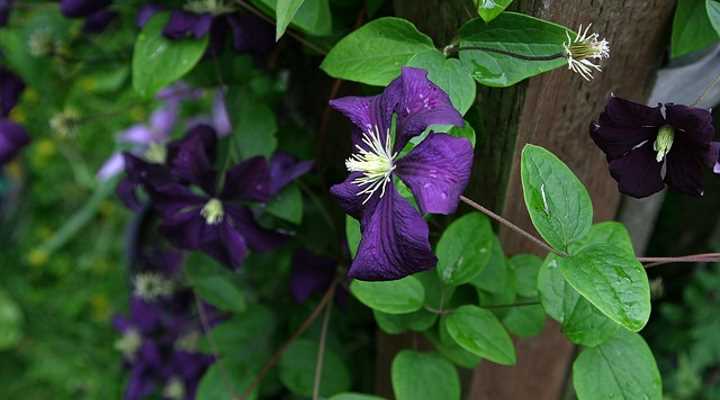
The wide variety of clematis vines include flowers in various colors and the vines are commonly used as climbers on trellises and fences
Clematis includes a wide range of climbing and vining plants with spectacular colorful flowers. These versatile fast growing vines quickly grow over fences, pergolas, arbors, or trellises. Flowering clematis vines have large, showy pink, purple or white flowers growing 5” to 10” (13 – 25 cm) across. Small-flowered clematis vines have flower clusters of bell-shaped or star-shaped drooping flowers.
Clematis vines grow 10 to 40 ft. (3 – 12 m) tall, depending on the variety. For example, Clematis Montana Group climbers have four-petalled, star-shaped pink flowers growing on flowering trails up to 40 ft. (12 m) long. Clematis Viticella Group vines are vigorous, free-flowering plants with a long-blooming period. These perennial vines are suitable for USDA zones 4 to 11.
Evergreen clematis vines have clusters of bell-shaped flowers with recurved petals. Ideal for growing in USDA zones 7 to 11, evergreen clematis provide privacy and beautiful flowers throughout the years as the scrambling vines cover fences, boundary walls, arches, arbors, or trellises.
Chocolate Vine (Akebia quinata)
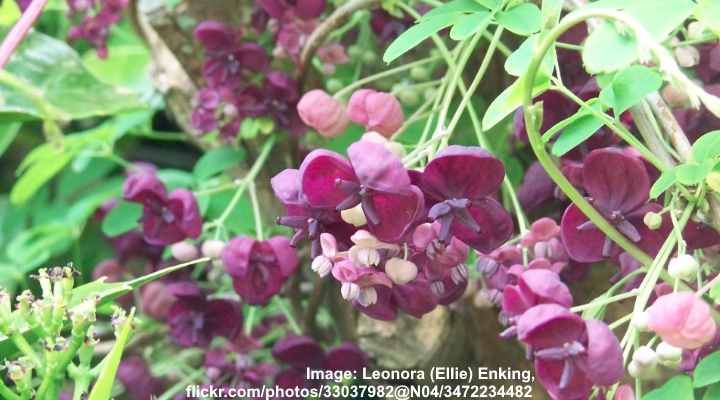
The chocolate vine has a vigorous growth and can quickly cover unattractive walls, fences or arbors
The chocolate vine is one of the fastest-growing flowering vines to cover a fence. The woody vining plant has semi-evergreen, twining stems covered in wine-red to deep purple flowers. These eye-catching purple flowers contrast nicely with bright green foliage and help to cover unsightly garden eyesores.
The chocolate vine grows 20 to 40 ft. (6 – 12 m) tall and is known for its vigorous growth. As well as growing to cover chain link fences or pergolas, you can let the spreading stems cover the ground, making it ideal as a ground cover plant for the shade. Suitable for USDA zones 5 to 9.
Related reading: Ground cover plants with purple flowers.
Wisteria

The stunning purple flowers of wisteria climbing plant dangle beautifully over arbors or pergolas
Wisteria is a spectacular ornamental vine with huge clusters of pea-like flowers hanging from woody stems. The dramatic floral displays can be 20” to 24” (50 – 60 cm) long and bloom in pure white, lilac, purple, and pastel pink colors. The woody wisteria stems can be trained to grow through chain link or wood-link fences.
Wisteria vines can become heavy. Therefore, if you plan on growing it as a fence barrier, it is a good idea to reinforce the fence before planting. This allows you to enjoy the colorful floral displays in summer and late fall. The foliage turns bronze and golden yellow in the fall, and velvety bean-like seed pods appear.
Wisteria vines are suitable for growing in USDA zones 5 to 8.
Related reading: Types of wisteria plants.
Bougainvillea

The large shrubby vines of bougainvillea spread along walls, climb up trellises, and cover arbors
Bougainvillea is a group of thorny tropical vining plants covered with spectacular red, pink, orange, white or purple flower-like bracts. These woody vines fill front and backyards with vibrant colors as they grow along fence lines and walls. Ideal for landscaping in USDA zones 9 to 11, the evergreen, colorful vine grows 8 to 40 ft. (2.4 – 12 m) tall and wide.
Morning Glory (Ipomoea purpurea)
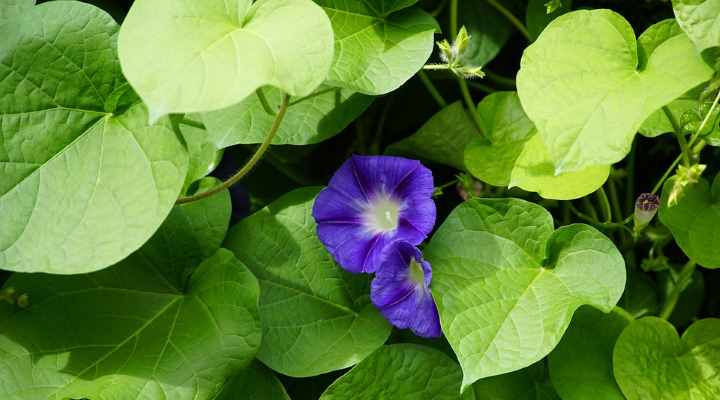
The fast growing morning glory vines are considered perennials in warmer climates and annuals in colder climates
Morning glory is an exotic vining plant with attractive funnel-shaped purple flowers, heart-shaped leaves, and a long-blooming time. Ideal for climbing over fences or walls, morning glory grows quickly to cover backyard eyesores. This fast-growing annual vine grows 6 to 10 ft. (1.8 – 3 m) tall and up to 6 ft. (1.8 m) wide.
Hardy morning glory vines are suitable for growing in USDA zones 2 to 11 in full sun. The vines bloom continuously with trumpet-shaped flowers 2” to 3” (5 – 7.5 cm) long, contrasting with densely growing foliage. Morning glory grows as an annual in colder climates and is a twining evergreen vine in warmer regions.
Black-Eyed Susan Vine (Thunbergia alata)

Black-eyed Susan vine thrives in full sun and looks great covering fences and trellises with its attractive yellow-orange flowers
The black-eyed Susan vine is a perfect choice if you want to add vibrant color, beautiful blooms, and texture to your landscape. This stunning flowering vine produces generous clusters of bright, yellow flowers with distinctive black eye centers which bloom continuously throughout the growing season. The heat-loving, sun-loving vine grows 3 to 8 ft. (1 – 2.4 m) tall.
Black-eyed Susan vines look great cascading over fences or walls when grown in full sun, fertile, well-drained soil. These spectacular yellow vines are also fast-growing and easy to maintain. This vigorous evergreen vine is suitable for growing in USDA zones 10 and 11. You can grow the vining plant in hanging baskets or containers in cooler climates and overwinter indoors.
Dutchman’s Pipe (Aristolochia macrophylla)
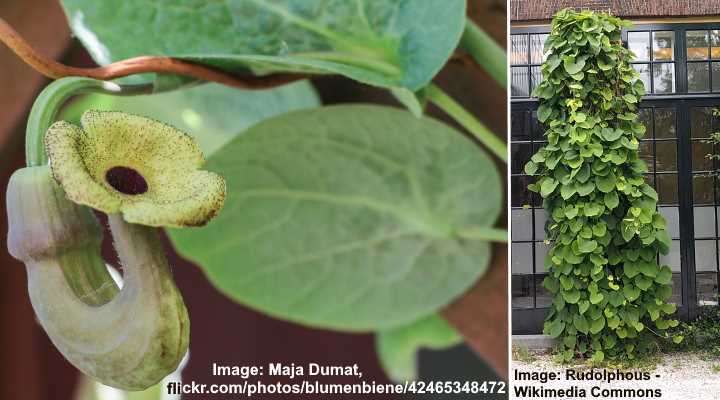
Dutchman’s pipe is a fence vine with an unusual looking flowers and densely growing attractive foliage
Dutchman’s pipe is a deciduous climber with large heart-shaped leaves, unusual pipe-shaped greenish flowers, and a vining habit. This vigorous vine has lush foliage that helps create a screen of attractive leaves. The woody stems grow 15 to 30 ft. (4.5 – 9 m) tall and up to 20 ft. (6 m) wide.
Dutchman’s pipe is ideal for covering a fence, trellis, or arbor due to its densely growing foliage. The hardy perennial is suitable for growing in USDA zones 5 to 8 and performs best in full sun or partial shade.
Purple Hyacinth (Dolichos lablab)
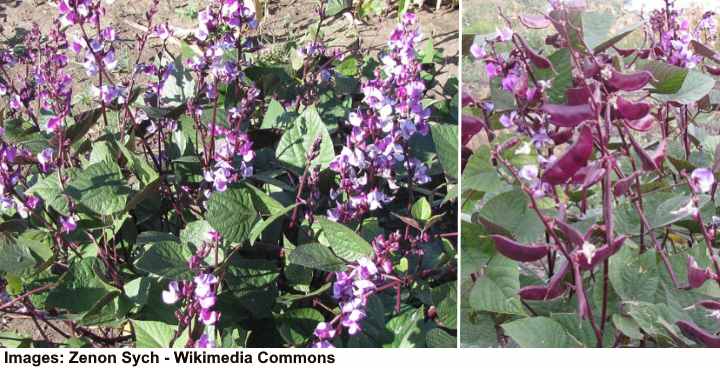
Purple hyacinth vine has delicate pink-purple flowers (left) and shiny purple seed pods (right)
Purple hyacinth is a vigorous ornamental vine that quickly covers fences with a mass of foliage and pinkish-purple blooms. The vine’s foliage consists of attractive heart-shaped leaves, and reddish-purple seed pods appear in the fall. These fast-growing vines can reach up to 20 ft. (6 m) in length and are perfect for adding a vibrant live element to your garden. In warm states like Florida, purple hyacinth is cultivated for its ornamental value.
Purple hyacinth vines can easily grow in full sun and in most soil types. The vigorous growers quickly create a natural ornamental screen if they get support along a fence line. Suitable as a perennial tropical vine in USDA zones 9 to 11.
Climbing Hydrangea (Hydrangea anomala subsp. Petiolaris)
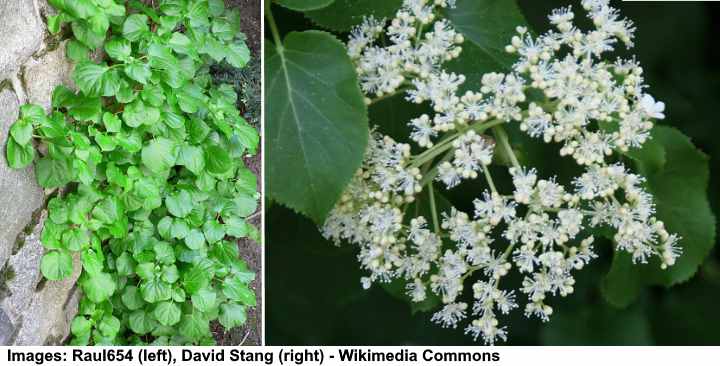
Climbing hydrangea can grow on house walls, fences or trellises adding ornamental value with its white flowers
Climbing hydrangea is a fast-growing deciduous shrub that clings to fences, trellises, and arbors with its aerial roots. The ornamental appeal of this climber is its sprays of creamy-white flowers, densely-growing lanceolate green leaves, and long blooming time. Climbing hydrangea grows 30 to 40 ft. (9 – 12 m) tall and up to 6 ft. (1.8 m) wide.
Cold-hardy in USDA zones 4 through 9, climbing hydrangea is an ideal landscaping vine throughout most of the United States. The climbing stems are ideal for covering unsightly fences and walls and look great growing over arbors. In addition, its attractive reddish-brown exfoliating bark adds visual appeal to a winter landscape.
Related articles: Types of hydrangea bushes.
Passion Flower Vine (Passiflora)
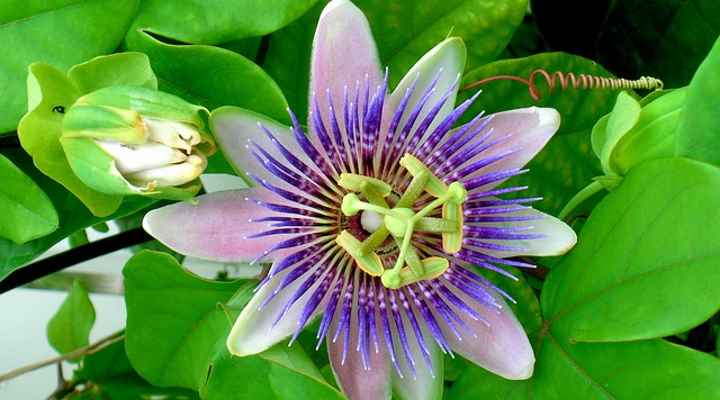
Passiflora is a flowering vine with stunning purple flowers that thrives in full sun and looks great covering fences or arbors
Passionflower is a hardy purple-flowering vining plant, ideal for climbing and trailing over fences, arbors, or trellises. The vigorous evergreen climber is known for its showy purple flowers with protruding stamens. The twining tendrils attach themselves to chicken wire and chain link fences, creating a natural wall of green foliage.
Passionflower tendril vines thrive outdoors in USDA zones 8 to 11 and in full sun or partial shade. The deciduous vining plants grow 10 to 30 ft. (3 – 9 m) tall. The exotic purple flowers, with their showy wiry filaments, bloom throughout the summer until fall. This drought-tolerant vine is perfect for covering ugly fences or walls or decorating trellises.
Evergreen Vines For Fences
Evergreen vines are a great choice for covering fences and walls as they provide year-round coverage. Some of the most popular evergreen vines include English ivy, Carolina jessamine, creeping fig and coral plant. Let’s look in detail at some of these evergreen vines for fences.
English Ivy (Hedera helix)

English ivy is a common evergreen vine with a fast growth habit which is suitable for covering fences and walls in shaded areas
English ivy is a fast-growing evergreen climbing plant that quickly covers fences, walls, and trellises with its glossy green foliage. The hardy plant has dark green leaves with three to five lobes, small greenish-white flowers, and vigorous growth. The most popular use of English ivy is to cover fences, walls, trellises, or ground cover.
English ivy is suitable for growing in USDA zones 4 to 9. Its spreading stems quickly attach themselves to most surfaces. In time, the climbing vine can grow 20 to 80 ft. (6 – 24 m) tall. It thrives in part shade to full shade. You can also let English ivy spread over the ground as a ground cover plant for shade.
Coral Plant (Berberidopsis corallina)
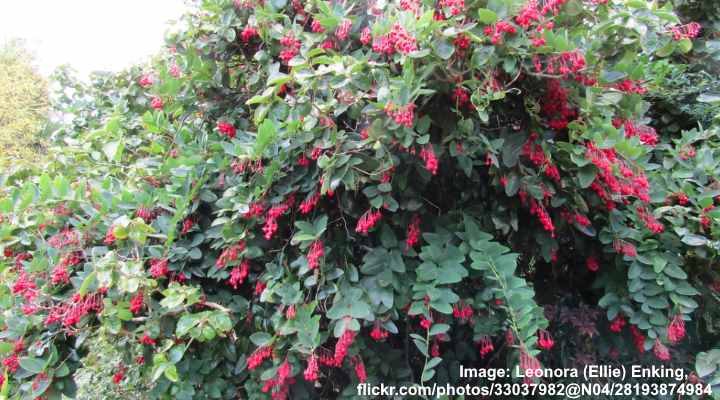
The evergreen coral plant is a beautiful climbing vine for partial shaded gardens
Coral plant is an evergreen vine with spectacular clusters of vibrant red flowers hanging from arching stems. The evergreen woody vine has dark green, heart-shaped leaves that contrast nicely with ruby-red flowers. This exotic twining shrub is ideal for growing in part shade to cover unsightly chain link fencing or retaining walls.
Coral plant grows 10 to 14 ft. (3 – 4.2 m) tall. Thriving in USDA zones 8 and 9, it’s an excellent climbing vine for partially shaded gardens in Florida, Texas, and the Carolinas. The pendulous clusters of bright red flowers will brighten up any backyard as they cover fences, arbors, pergolas, or trellises.
Carolina Jessamine (Gelsemium sempervirens)
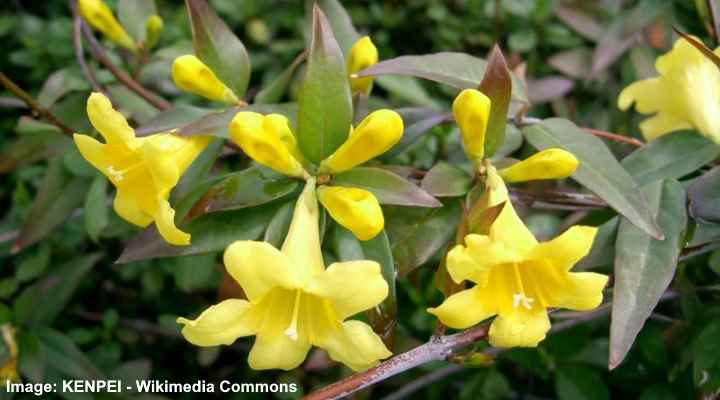
The yellow flowering Carolina jessamine is an evergreen vine that thrives in full sun but can tolerate light shade
Carolina jessamine is an evergreen climbing vine noted for its stunning golden yellow trumpet-like flowers. This winter-blooming evergreen vine has dense foliage that creates a year-long privacy screen or natural fence. Its large clusters of fragrant buttery-yellow flowers bloom in late winter through late summer. The heat-loving vine grows 10 to 20 ft. (3 – 6 m) tall.
Carolina Jessamine is a perfect vining plant to scramble over fences, garden structures, or climb trees. Additionally, you can let the spreading plant grow over the ground as flowering evergreen ground cover. Suitable for planting in USDA zones 7 to 10.
Related reading: Shrubs and vines that grow in Texas.
Creeping Fig (Ficus pumila)
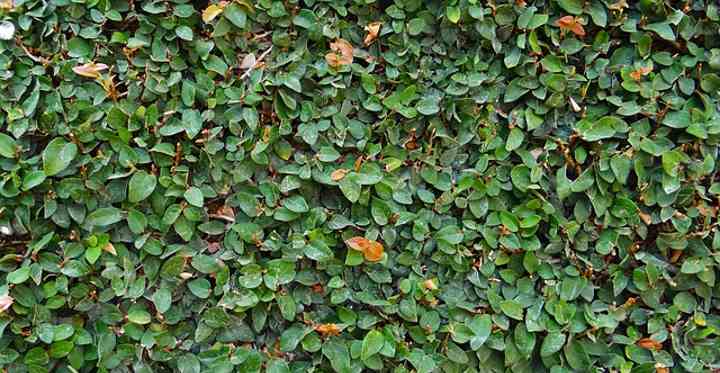
Creeping fig is an easy to grow climbing vine that quickly covers walls and fences with its evergreen foliage in warmer climates
Creeping fig is an evergreen climbing vine with leathery heart-shaped leaves growing on reddish stems. This fast-growing vine quickly covers fences, walls, or trellises with glossy green foliage. The vine also produces pear-shaped purple fruits that grow throughout the year in warmer climates. Creeping fig grows 10 to 15 ft. (3 – 4.5 m) tall and 3 to 6 ft. (1 – 1.8 m) wide.
Creeping fig is suitable for growing in USDA zones 9 to 11. As well as growing over fences, the vine is suitable as ground cover, in containers, or as an attractive indoor houseplant.
Related reading: Outdoors and indoors ficus plants.
Related articles:
